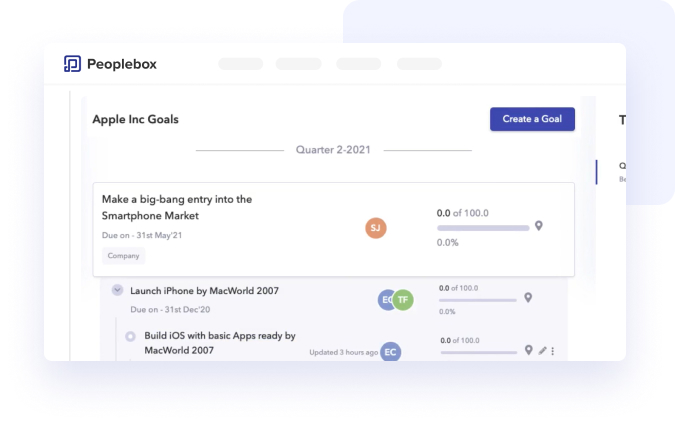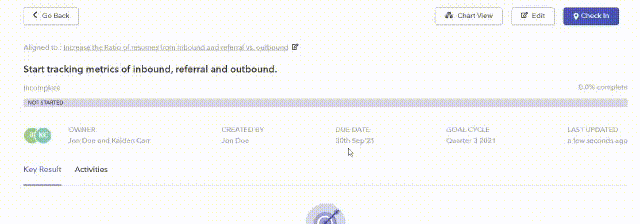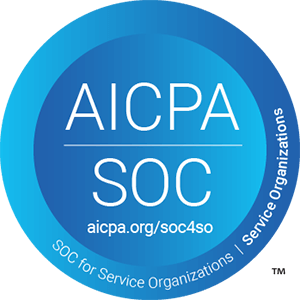
OKRs helps in planning and evaluating a company’s success. As vital as it is to deploy them in your organization,not tracking OKRs can cause you to lose sight of the company’s growth. This might be one of the reasons why your OKRs fail.
It is not the right attitude to set OKRs and forget them. They need to be tracked regularly to avoid blind spots and reap better business outcomes. Most of the companies succeed in OKR tracking as they align their mission,vision and values in an effective way.
But before establishing OKRs, it is crucial to ensure that every team member or employee is on the same page and understands the goal to be achieved and the strategy to be applied.
“Employees are probably more valuable when their mission is focused.”
-Sundar Pichai.
What is OKR Tracking?
OKR tracking is the process of monitoring the progress of assigned OKRs. Waiting for OKRs to be finished after setting them is not the best strategy to apply them in the organization.
Following the establishment of OKRs, the next important step is tracking, which is often neglected.
For example, the marketing team has been assigned the following OKR:
Objective: Be the best blog in the industry
Key Results:
- Post 75 blogs per month
- Get 5,0000 people to subscribe to the blog
- Enhance SEO score to 99
Now that the assigned OKR period is over it’s time to review OKR, are the KRs successfully achieved? You will be able to answer this only when you track the OKRs.
Benefits of OKR Tracking
1. Avoid blindspots
Often the progress of OKRs is overlooked and if it goes unnoticed for too long can result in failures or non-accomplishment of OKRs. Are you ready to take that risk?
Of course not, tracking Objective and Key Results can help you overcome these issues and achieve goals at a defined time.
2. Stay on top of your goals
OKRs are the foundation of organizational goals. OKR tarcking allows you to plan for future OKRs, goals, and strategies accordingly. It helps you set a clear path for functioning and reviewing processes for OKRs.
According to Lazaro Ibanez “Google adopted to stay on top of their goals using OKR in 1999, during its first year. It supported Google’s growth from 40 employees to more than 60,000 today”-
The goals can be better envisioned if you figure out what you want and why you want.
“For many of us, the problem isn’t dreaming up the goals we want to accomplish; it’s remembering to continue pursuing them in spite of all the other things that need to get done in one day”
-Ana Mcrae.
3. Align teams regularly on goals
What if a team finished their OKRs ahead of schedule, or if someone is struggling to complete their OKRs? Keeping track of progress enables you to align teams with goals, ensuring that everyone is on the same page and moving in the same direction.

4. Define a clear path
Objectives without a clear path to follow are ineffective. You’ll need measurable and practical actions to get you from one point to another while also being able to track your progress.
5. Provide Guidance when needed
Just setting OKRs isn’t enough to improve employees’ performance, by keeping a track of their OKR progress and performance you can provide real-time feedback and they can work on it to complete the objective in the given time.
Tracking helps in identifying the solutions for the challenges at the team level.
6. Helps in identifying any issues
By keeping track of OKRs you can easily identify any errors and make corrections accordingly in the right time instead of doing all these changes at the time of review.
This helps in saving time and extra effort of both managers and employees.
OKR Tracking Challenges You Might Face
1. Multiple objectives
For a large organization with several teams and multiple OKRs, it is often difficult to keep track of every OKR. Too many objectives also disturb the focus of teams on what is important and confuses them as well.
In a simple language, you must concentrate more on the quality, not on the quantity of the Objectives.
2. Failing to track progress weekly
One of the key reasons OKRs are so beneficial is that they make it simple for managers to track progress. The hitch is that they must check in on a regular basis in order to instill discipline in their teams.
If your team establishes targets at the start of the quarter during quarterly planning, but you don’t check in on progress for many weeks, you’ll likely discover that not much has been accomplished.

3. Not assigning a DRI (Directly Responsible Individual)
Tracking isn’t an easy job when there are various teams assigned with different OKRs. Also, if a manager is assigning, tracking, and reviewing OKRs along with other jobs, he/she might lose focus on important projects or tasks.
A DRI is in charge of ensuring that OKRs are accomplished. Failure to appoint a single person to be accountable for OKR development can result in a lack of discipline and blaming of other team members for non accomplishments.
4. Poor resources
One of the biggest mistakes a manager can make is to encourage their team members to undertake something without providing them with the necessary resources. As much as reliable resources are important for team members while allocating OKRs, they are really useful while tracking them as well as they will help managers equally.
5. Unmeasurable KRs
Remember that Objectives are ambitious goals, and KRs are the measures of an objective’s success. Key Results help you define success and comprehend when you can declare, “We did it!” Key Results are not tasks to complete an Objective.
Therefore, Key Results should be numerical in order to measure progress toward your Goal.
“If it does not have a number, it is not a Key Result.” – -Marissa Meyer, former Google VP
How to Track OKRs?
Here’s a quick to-do list that will help you and your team members OKR tracking. Let’s explore the list below.
1. Focus on qualitative objectives and quantitative key results
The key to successful OKR tracking is setting qualitative objectives and quantitative key results. Be clear about writing the objectives so that you and your team are clear about what
Qualities you wish to achieve at the end of the task completion.
For example:
Objective: Boost more conversions on our online store.
Whereas, your key results must have a quantitative measure that helps the team understand their targets hassle-free. For example:
Key Results #1: Offering a 5% discount to first-time customers on shipping charges.
KR #2: Send 15% discount coupons to returning customers to encourage them to shop at your online store.
KR #3: Open an inside community where members can receive discounts up to 50%.
These results can help you increase conversions for your online store and ensure the team members are clear with their goals during the process.
Also Read: Easy Tips for Writing OKRs [With Examples]
2. Be clear about what to measure in your key results
It becomes easier for you to track your OKRs when you know what to measure in your key results. Try to avoid as much as vagueness when creating your key results for each objective. The measurement of each key result should help you:
- Track the number of new people who got added as your new customers
- Monitor how many customers returned to your business during a certain period
- Track how many customers converted into brand advocates and decided to be a part of your inside community
These aspects will help you collect essential data that will help you understand whether you are close to meeting your goals and set future goals for the team.
3. Don’t miss out on OKR software
Want to track all your OKRs in one place and ensure your team is on track with the set deadlines? Get an OKR software solution for your business.

OKR solutions like Peoplebox help your team members get frequent reminders or nudges for upcoming or ongoing OKR so that they can finish them before the deadlines. You can also track the progress of each task through its single-view dashboard. This helps you see how each task is progressing and which team member is in-charge of its completion. In a nutshell, it offers you the best way to track all your OKRs in one place.
It also provides 100+ native integrations to update the progress on your OKRs automatically.
What’s more, you can get insights on how a task is progressing and identify possible reasons why it may come across roadblocks before completion. Such insights and more encourage the use of OKR software amidst those who follow this goal setting approach.
4. Start initiatives that drive results
You want your OKRs to achieve your company goals, right? Well, to drive them in the right direction, it is important to set initiatives for such OKRs. You may feel that the initiatives you’ve started for your business aren’t measurable, then what’s the point of having them in the first place.
However, if you set the right initiatives, you’ll see a steady impact on the key results that help you achieve your objectives. For example, you can set the following initiatives for the key results.
Initiative #1: Train members on how to introduce discounts to website visitors and returning visitors.
Initiative #2: Upgrading the website for a better purchasing experience.
These initiatives would help you enhance the key results and ultimately help your team members achieve the set objectives.
OKRs are the foundation of organizational goals. Tracking OKRs allows you to plan for future OKRs, goals, and strategies accordingly. It helps you set a clear path for functioning and reviewing processes for OKRs.
According to Lazaro Ibanez “Google adopted to stay on top of their goals using OKR in 1999, during its first year. It supported Google’s growth from 40 employees to more than 60,000 today”
The goals can be better envisioned if you figure out what you want and why you want.
“For many of us, the problem isn’t dreaming up the goals we want to accomplish; it’s remembering to continue pursuing them in spite of all the other things that need to get done in one day”
OKR Software – Used by 500+ Companies
Transform your managers into leaders through personalized coaching, bite-size learnings and make it super easy for them to have meaningful 1:1s, check-ins, and align goals(OKRs).
How to Avoid Common OKR Tracking Mistakes
1 Assign a directly responsible individual
Often when there are many employees and teams assigned with multiple OKRs, it becomes challenging for a manager to keep regular track of OKRs, here a manager can assign a DRI (Directly Responsible Individual) for each OKR to keep track of the progress on his/her behalf.
2 Use OKR tool
Getting an OKR tool into the play can help you not just with OKR tracking but measuring them too. The tool connects every employee to an organization’s goals, vision, and expectations, allowing them to track progress in a dashboard and share and receive direct feedback. Members can reflect on the progress via notification alerts, making tracking objectives easy.
3 Provide regular feedback
While tracking if you find there is an error or scope for improvement you should immediately connect with the team through 1:1s and work on it there and then only to avoid wastage of time and efforts later on.

4 Track OKRs for accountability
OKRs are data-driven. Regular check-ins, objective grading, and constant reassessment guarantee complete control and accountability at the end of the quarter.
“There always needs to be someone steering the ship, though, even if the crew is responsible for helping get it safely to the harbour. With OKRs, it’s incredibly important to have a capable individual in charge of the objective. They need to know exactly what’s expected and how it will be measured so they can oversee the process and ensure progress is made.”
-Dan Bailey, President of WikiLawn
5 Set OKRs quarterly
Without a question, OKRs are an effective way to boost employee productivity and performance. However, they must be established for a fair amount of time so that they do not interfere with the company’s growth.
Setting OKRs on a regular or weekly basis can result in significant administrative burden because you’ll continually be setting, tracking, and reviewing them. Setting OKRs quarterly can help balance both employees’ and company’s growth.
6 Set 3–5 KRs per objective
Too many objectives or key results can divert attention away from your priorities. Teams should have a maximum of three objectives every quarter, each with up to 3-5 key results. As a result, the amount of work will be a lot more reasonable and less perplexing.
An objective in OKRs must be supported by at least 3-5 Key results as they describe how you plan to reach your objective in a sensible and practical manner.

Keeping track of OKRs allows you to monitor team performance and, if there are any gaps, they must be filled in accordance with your direction and encouragement. With quarterly OKRs you must conduct weekly check-ins to track the progress of OKRs.
Role of Weekly OKR Check-ins
An OKR check-in is a short 15-20 minute session when you and your team reflect on OKR success and create new priorities for the following week. The check-in serves to support OKR progress. Teams ensure that progress is being made by evaluating completed plans, the outcomes and the lessons gained as they move ahead.

1 Progress in the Key Result since last check-in
How much progress has the team made since the last checkin? Has it improved? What are the chances of achieving each Key Results?
2 What went right or what went wrong
What are the obstacles your team is facing? How is it restricting them to work on OKRs? Is it an internal or external factor? How can it be solved?
3 What did team members learned
Understanding what team members have learned and what they can work in future helps you write OKRs for the next quarter.

4 Updated plan for next week team OKRs
Plan how the teams are going to work on OKR next week, who will perform what task, what targets have been set.
5 Performance of team members
Weekly check-ins are a great way to analyze the individual performance and motivate or praise them accordingly.
OKR Software – Rated 4.8 on G2
Empower your managers to be a better leader with essential performance tools & personalized coaching support.
Role of Integrations for OKR tracking
Slack integration
Slack is one amazing business messaging tool for any sized organization. You can integrate slack with the OKR tool You can track progress with the OKR tool and set weekly check-in meetings with slack. This ensures that everyone in the team is aware of the progress and are on the same page.
Integrating OKR and 1:1s
It allows you to conduct regular meetings to keep track of OKRs. Effectively using this integration enhances productivity, keeps track of OKRs and boosts employee morale.
After all the tips and tools discussed above now is the time to score the OKRs

OKR scoring
Scoring OKR refers to the process of setting criteria for evaluating key Results achievement. For example, a low score would mean a rework with the feedback and high score give actual evidence of delivery.
According to Rick Klau, at Google Key results are scored between 0.0 to 1.1, where 1.0 means the objective was achieved. You can also use the percentage approach or ‘A’ to ‘F’ approach for grading or whatever suits the organization best.
Points to consider while scoring OKRs
To determine a score, divide the set target by the final result. Using the previous example, if your team’s KR was to “post 15 blogs,” but they only got 10, their final score would be 0.6, whereas if they got 13, their score would be 0.8. A score can be assigned to the Key Result based on this score.
A lower score may indicate that the organization is not achieving its full potential. With Google’s 0.0 – 1.0 scale, an average of 0.6 to 0.7 across all OKRs is expected.
It is critical to understand that a low score (0.2 – 0.4) does not always indicate that your employees are not hard working.
Rather, a low score should be reviewed to determine what is preventing your employees from scoring higher. Perhaps the issue isn’t with them, but with the KR, which needs to be reworked.
Conclusion
OKRs are a fantastic approach to guarantee that your organization is aligned around shared goals and that it continues to develop and expand in a constructive, collaborative direction.
The process of OKR tracking as a team can also help employees stay more committed and engaged in the company’s high-level goals, allowing them to focus their daily efforts on the most important tasks.
You can have a successful landing by following a tracking guide and remember a few things like setting OKRs quarterly, evaluating the progress with weekly check-ins, integrating OKR tracking tool and slack can help with the achievement of OKRs efficiently.
FAQ
How to manage OKRs?
Effective OKR management involves defining clear objectives and measurable key results aligned with your organization’s mission. Focus on a few meaningful goals, cascade them throughout the hierarchy, track progress regularly, and remain adaptable. Transparent communication, celebrating milestones, and learning from each cycle further enhance the process.
What is OKR software?
OKR software is a digital tool or platform designed to help individuals, teams, and organizations effectively set, track, manage, and communicate their Objectives and Key Results. It streamlines the OKR process and enhances collaboration and visibility. It typically includes features such as goal setting and tracking, progress visualization through dashboards, collaboration tools for teams to work together on OKRs, integration capabilities with other tools, and reporting functionalities for performance analysis.





